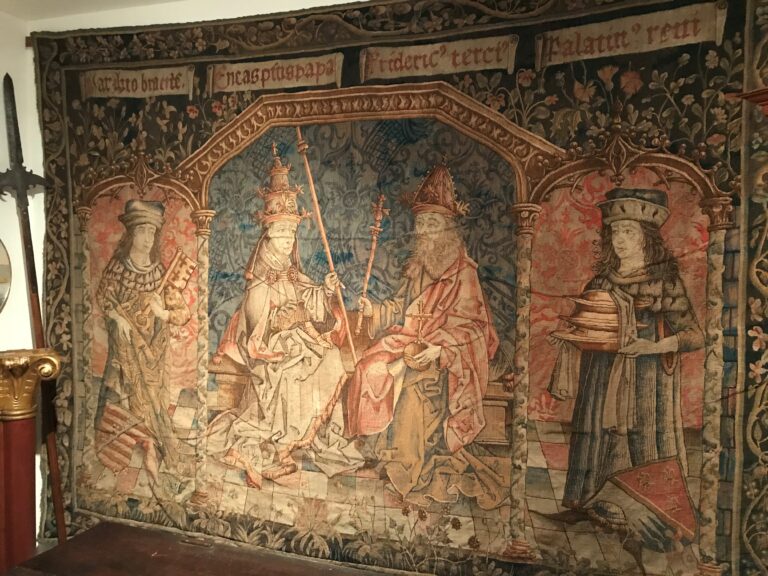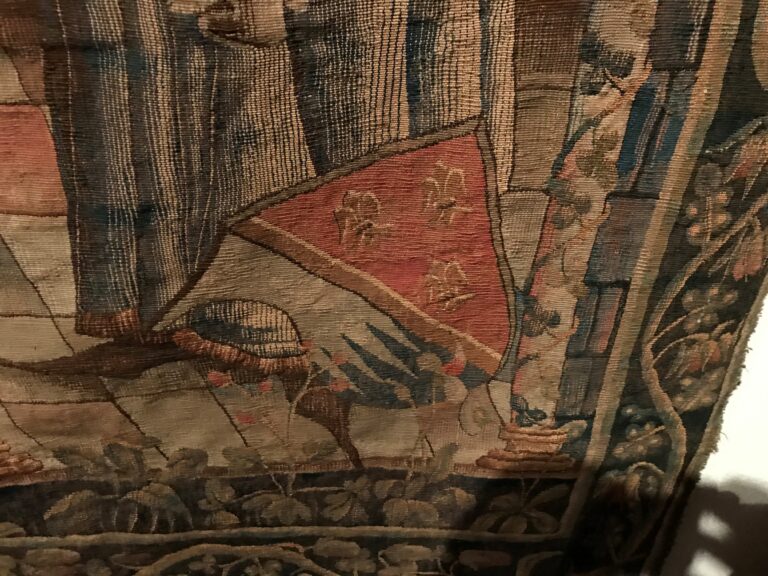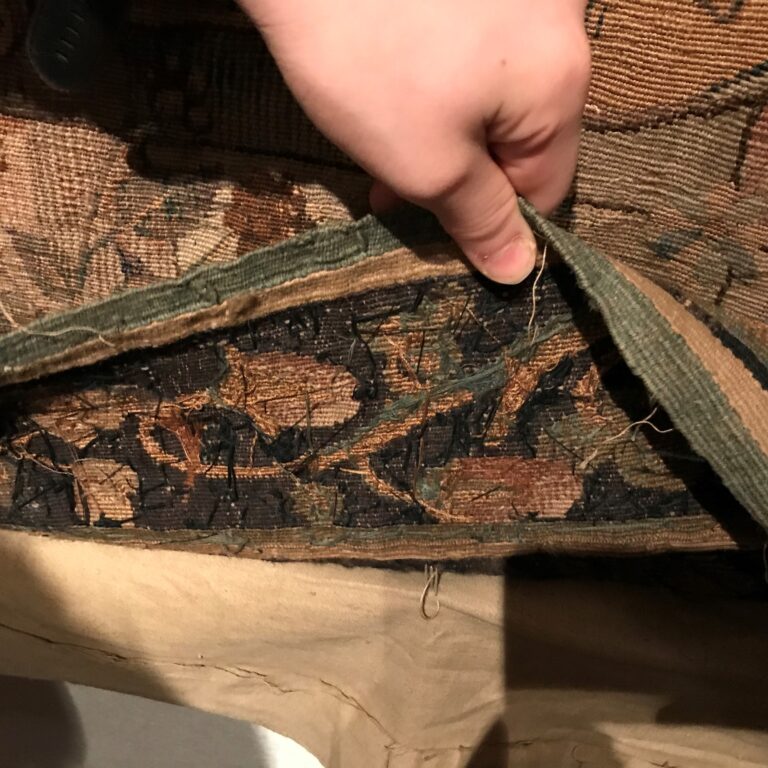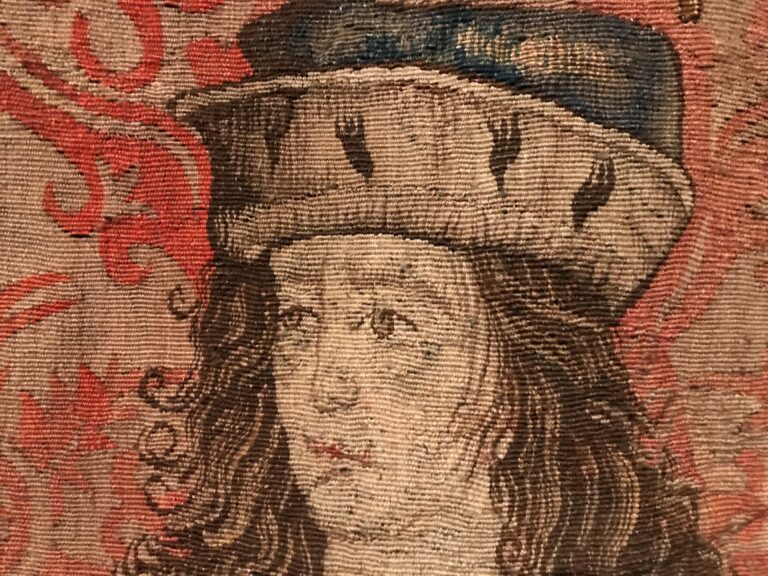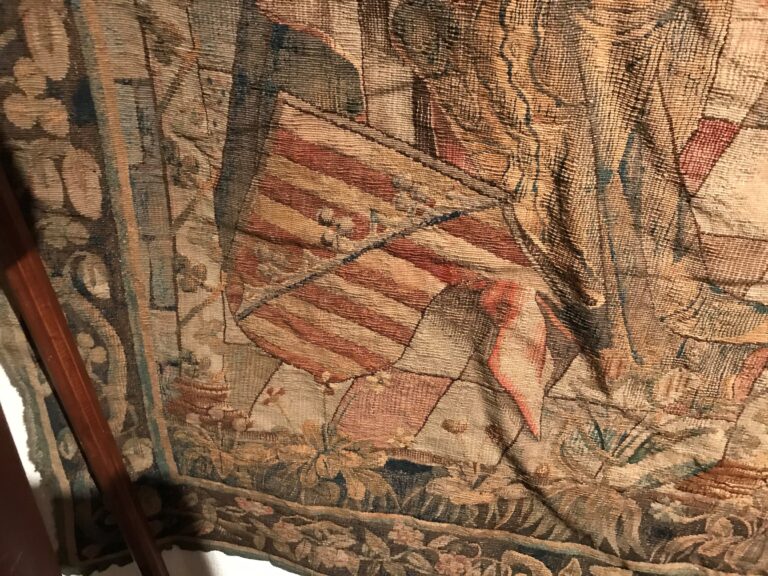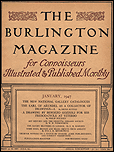
A Fifteenth-Century Tapestry
Author(s): C. H. W.
Source: The Burlington Magazine for Connoisseurs, Vol. 12, No. 56 (Nov., 1907), pp. 100-102
Published by: Burlington Magazine Publications Ltd.
Stable URL: https://www.jstor.org/stable/857141
Accessed: 27-02-2020 16:14 UTC
NOTES ON VARIOUS WORKS OF ART
A FIFTEENTH-CENTURY TAPESTRY AN exceptionally interesting tapestry, which we are enabled to reproduce by the courtesy of the owner, was discovered in the crypt of a church in Spain around the turn of the 20th century (around 1905). Its main interest centres in the curious historical discrepancies in the representation of the subject which the designer evidently intended to com- memorate. Taking first into c onsideration the principal figures in the tapestry, which undoubtedly are the two in the centre panel, no uncertainty is allowed to rest in our minds as to the  personages intended to be represented, for above them we have descriptive labels inscribed respectively ENEAS PIUS PAPA and FRIDERIC‘ TERCI‘; otherwise, in plain English, Aeneas Sylvius Piccolomini, Pope Plus II, and the Emperor Frederick III of the Holy Roman Empire. In connexion with the former the following are the principal events in his biography: scion of a poor but noble family, he was educated at the universities of Siena and Florence, where he soon gave proof of remarkable intellectual capability. In 1431 he became secretary to Cardinal Domenico Capranica, bishop of Fermo; in 1442 he went to the court of Frederick III at Vienna, who gave him the crown of poet laureate; soon afterwards he entered into Holy Orders, and in 1447 Pope Nicolas V made him bishop of Trieste. In 1450 Frederick sent him to Portugal to negotiate his marriage with the Princess Leonora, in which he was successful, and in 1452 he accompanied the emperor to Rome, where the latter was crowned king of the Romans by Pope Nicolas V, and was also married to the Princess Leonora of Portugal. Aeneas was again dispatched to Rome in 1455 to offer the obedience :of Germany to the new pope, Calixtus III, and finally, in 1458, himself received the papal tiara as Pius II.
personages intended to be represented, for above them we have descriptive labels inscribed respectively ENEAS PIUS PAPA and FRIDERIC‘ TERCI‘; otherwise, in plain English, Aeneas Sylvius Piccolomini, Pope Plus II, and the Emperor Frederick III of the Holy Roman Empire. In connexion with the former the following are the principal events in his biography: scion of a poor but noble family, he was educated at the universities of Siena and Florence, where he soon gave proof of remarkable intellectual capability. In 1431 he became secretary to Cardinal Domenico Capranica, bishop of Fermo; in 1442 he went to the court of Frederick III at Vienna, who gave him the crown of poet laureate; soon afterwards he entered into Holy Orders, and in 1447 Pope Nicolas V made him bishop of Trieste. In 1450 Frederick sent him to Portugal to negotiate his marriage with the Princess Leonora, in which he was successful, and in 1452 he accompanied the emperor to Rome, where the latter was crowned king of the Romans by Pope Nicolas V, and was also married to the Princess Leonora of Portugal. Aeneas was again dispatched to Rome in 1455 to offer the obedience :of Germany to the new pope, Calixtus III, and finally, in 1458, himself received the papal tiara as Pius II.
The personages represented in the two side panels are not so easily identified-that is, so far as their actual personality is concerned-but there is no doubt as to their significance. The man on the right, who is carrying three covered dishes and wears an imperial electoral cap, would, even with- out the descriptive label above, be at once identified as representing the  Rhenish Palatinate. His pre- sence on the tapestry is the key to the whole story, but at the same time he complicates the situation considerably. The dishes which he carries prove that the tapestry is commemorative of the corona- tion of the Emperor Frederick III at Rome in 1452, for, as is well known to all students of coronation forms and ceremonies of that period, it was the privilege of the Elector Palatine to place four silver dishes, each of three marks, bearing meats, before the emperor, seated at the imperial table. It has not, as yet, been found possible to identify the arms on the shield at the foot of this panel. They undoubtedly belong to some noble sent to represent the Count Palatine of the Rhine, who is known not to have personally accompanied the emperor to Rome; but the dishes, the electoral cap and the inscription on the label above, PALATIN‘ RENI, are amply sufficient evidence of the occasion which this tapestry is intended to commemorate. The panel on the left owes its explanation more to the armorial shield at the foot than to any of the other details. The inscription on the label is far from clear, but appears to refer to the Mar- gravate of Brandenburg, which, until it came into the possession of the ancestor of the present German Emperor, was part of the kingdom of Saxony. Fortunately the identification of this personage is not essential: the Saxon arms and the electoral cap sufficientlydecl are his position in the empire. Let us now consider the position at which we
Rhenish Palatinate. His pre- sence on the tapestry is the key to the whole story, but at the same time he complicates the situation considerably. The dishes which he carries prove that the tapestry is commemorative of the corona- tion of the Emperor Frederick III at Rome in 1452, for, as is well known to all students of coronation forms and ceremonies of that period, it was the privilege of the Elector Palatine to place four silver dishes, each of three marks, bearing meats, before the emperor, seated at the imperial table. It has not, as yet, been found possible to identify the arms on the shield at the foot of this panel. They undoubtedly belong to some noble sent to represent the Count Palatine of the Rhine, who is known not to have personally accompanied the emperor to Rome; but the dishes, the electoral cap and the inscription on the label above, PALATIN‘ RENI, are amply sufficient evidence of the occasion which this tapestry is intended to commemorate. The panel on the left owes its explanation more to the armorial shield at the foot than to any of the other details. The inscription on the label is far from clear, but appears to refer to the Mar- gravate of Brandenburg, which, until it came into the possession of the ancestor of the present German Emperor, was part of the kingdom of Saxony. Fortunately the identification of this personage is not essential: the Saxon arms and the electoral cap sufficientlydecl are his position in the empire. Let us now consider the position at which we
have arrived. In the centre we have Pope Pius II and the Emperor Frederick III seated on the same bench, both wearing sumptuous robes and bear- ing the insignia of their office ; they are attended by two of the Electors of the Holy Roman Empire, one of whom, the Palatine representative, carries the dishes symbolical of the coronation. This tapestry, therefore, can only be commemorative of one event, namely, the coronation of the Emperor Frederick at Rome in 1452. As we have already stated, the representative of the Palatinate with his dishes is the key to the whole situation; otherwise it might have been suggested that the tapestry only depicted an ordinary meeting of the emperor and pope. For we are in face of this difficulty, namely, that the coronation, which took place in 1452, was performed by Pope Nicolas V, Aeneas Sylvius being only a member of the emperor’s suite and taking only a secondary posi- tion in the proceedings. The successor to Nicolas was  Calixtus III, and it was not till 1458 that Aeneas became pope; it is not recorded that Frederick had any further meetings with him, and even if such meetings had taken place there would have been no reason for depicting the Elector Palatine’s representative with the insignia of the coronation ceremony. These great discrepancies do not, however, by any means divest the tapestry of its historical and archaeological interest, for by negative evidence they give us great assistance in dating its period of manufacture. As we have already stated, Aeneas Sylvius did not attain to the papacy until 1458, or six years after the coronation, so that the tapestry must have been made subsequently to 1458. It is also improbable that it was made during that pope’s life, for during his brief reign, 1458-T464, the great event of the coronation and the emperor’s journey to Rome would have been too fresh in the public mind for such a mistake to have been made. We have, however, to recollect that the Emperor Frederick’s reign was of very long duration ; he did not die till 1493, and it would, therefore, not be difficult for people during an illiterate age to forget within the last ten or fifteen years before the emperor’s death the date of the pontificate of Pius II. The fact that he had been an important personage in the court entourage in the early years of the emperor’s reign, and that he had become pope under the title of Pius II, would be sufficiently near the mark for it to have been assumed by a careless designer that Pius II was the officiating pontiff at the coronation in Rome in 1452. It seems probable, therefore, that this tapestry
Calixtus III, and it was not till 1458 that Aeneas became pope; it is not recorded that Frederick had any further meetings with him, and even if such meetings had taken place there would have been no reason for depicting the Elector Palatine’s representative with the insignia of the coronation ceremony. These great discrepancies do not, however, by any means divest the tapestry of its historical and archaeological interest, for by negative evidence they give us great assistance in dating its period of manufacture. As we have already stated, Aeneas Sylvius did not attain to the papacy until 1458, or six years after the coronation, so that the tapestry must have been made subsequently to 1458. It is also improbable that it was made during that pope’s life, for during his brief reign, 1458-T464, the great event of the coronation and the emperor’s journey to Rome would have been too fresh in the public mind for such a mistake to have been made. We have, however, to recollect that the Emperor Frederick’s reign was of very long duration ; he did not die till 1493, and it would, therefore, not be difficult for people during an illiterate age to forget within the last ten or fifteen years before the emperor’s death the date of the pontificate of Pius II. The fact that he had been an important personage in the court entourage in the early years of the emperor’s reign, and that he had become pope under the title of Pius II, would be sufficiently near the mark for it to have been assumed by a careless designer that Pius II was the officiating pontiff at the coronation in Rome in 1452. It seems probable, therefore, that this tapestry  formed one of a series made not earlier than 1475, and possibly a few years later, commemorating some of the principal events in the reign of Frederick III. The style is decidedly characteristic of Flemish work of the second half of the fifteenth century, although the general conception of the design and the execution of the details are inferior to that of the best specimens of the Flemish tapestry weavers‘ art of that period. But whatever it may lack in quality as compared with some of the fine specimens of that period still existing is more than compensated for by the interest it has for us as a historical document. C. H. W.
formed one of a series made not earlier than 1475, and possibly a few years later, commemorating some of the principal events in the reign of Frederick III. The style is decidedly characteristic of Flemish work of the second half of the fifteenth century, although the general conception of the design and the execution of the details are inferior to that of the best specimens of the Flemish tapestry weavers‘ art of that period. But whatever it may lack in quality as compared with some of the fine specimens of that period still existing is more than compensated for by the interest it has for us as a historical document. C. H. W.
1′ Vol. i, (I718) p. 214.
2′ Arnold Houbraken und seine Groot Schoubergh,‘ p.209.
3′ Studien,‘ p. 343, etc.
